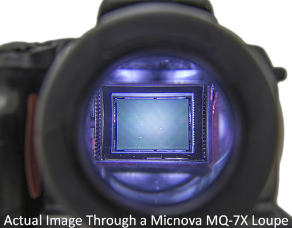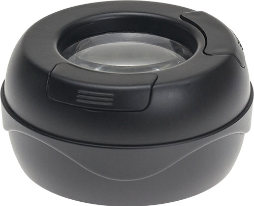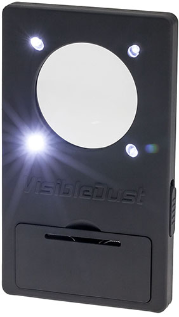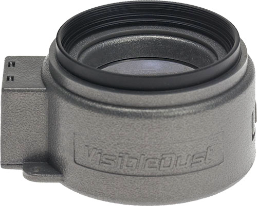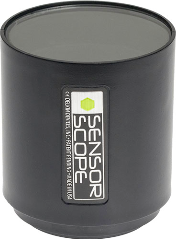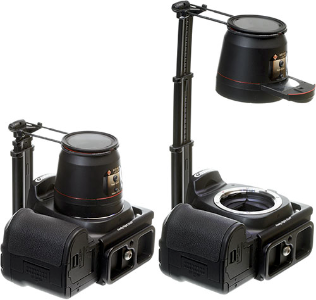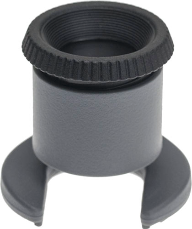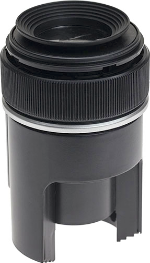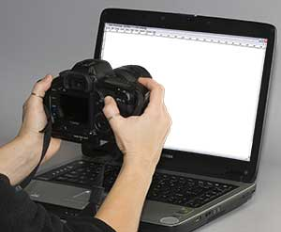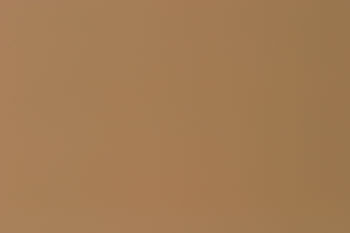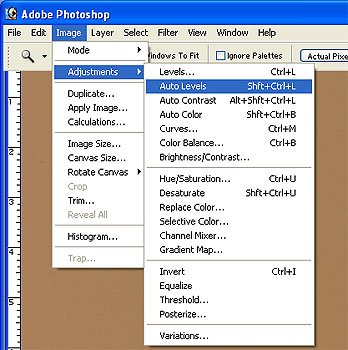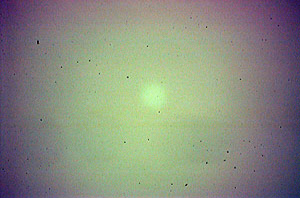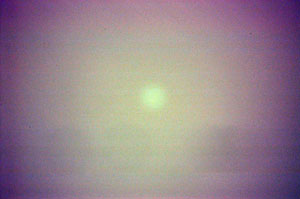Inspecting For Dust
Using a sensor inspection device instead of shooting and inspecting test images will save you an enormous amount of time when cleaning your D-SLR Sensor. If you don't yet have an inspection device, I highly recommend that you go out and buy one now.
The original method of shooting a test image is very time consuming, taking anywhere from 3-15 minutes for each inspection. The steps for the original method are listed below.
- Take your camera out of its cleaning mode
- Re-attach the lens
- Re-insert the media
- Set the camera settings for shooting shoot a test image
- Shoot the test image
- Pull the media out of the camera
- Insert the media into your computer
- Open the file just shot with Photoshop
- Change the settings of the image (levels) with Photoshop to be able to see the dust spots
- Remove the lens from the camera
- Put the camera in its cleaning mode
- Now clean (remember: the image in Photoshop is vertically flipped from when you are looking at your sensor)
Now we do it with the sensor inspection device.
- Pick up device and turn on the lamp
- Place device over the lens mount and look through it to see the sensor
As you can see, there is a BIG difference in time: five seconds versus 3-15 minutes. Don't forget that you will more than likely have to do this many times during just one cleaning session. The sensor inspection devices also give you the freedom to be able to clean your sensor on location without a computer. Inspecting your sensor after any cleaning is a requirement if you want to ensure dust-free photography.
Taking a Look at Sensor Inspection Devices
I strongly feel that owning a sensor inspecting device is as important as having a blower because even with a blower you need to inspect your sensor. The list of devices below are in order of recommended devices, the most favorable being at the top of the list. I rated these based on the fact that I have full frame cameras as do many others. The image above is to scale so you can tell how the size of one compares to another. Any of these are better than none at all. When selecting a sensor inspection device, magnification isn’t everything, not to mention that many manufacturers claim higher magnification than their devices actually are.
The second factor that is just as important as magnification, if not more, is field of view. Field of view is even more critical with full frame cameras than others. Think of your eye as being 1X. Now stick an empty toilet paper roll tube in front of your eye and look through it. You are still at 1X but you just restricted your field of view. Now grab an empty tube from a roll of paper towels and do the same. You just restricted your field of view even more. To improve your field of view you can do two things: use a short tube and/or use a larger diameter tube. To see the far corners and edges of a full frame camera’s sensor without moving your head all over the place, you want a sensor inspection device that has a good field of view.
When it comes to using a sensor inspection device, there actually is a trick to be able to see the smaller dust particles. If the dust particles are large, it will be easy for you to focus your eyes on them. If you don’t have any large particles to focus on, it may be hard to see the small ones. It’s kind of like when people walk into sliding glass doors. The reason they walked into that door was because the glass was clean and they were focusing past/through the glass and never saw it. Those big chunks of dust on your sensor work just like decorations we may put on a sliding glass door and we can focus on them easily. When we don’t have those big focusing aids on the sensor, you may find it easier to focus your eyes on the edge of the sensor on the frame that is holding the filter in. After being able to focus on the edge, use focus lock with your eye and scan the surface of the sensor for dust.
MQ-7X Sensor Inspection Scope by Micnova - Six Ultra-bright LEDs, Multicoated high definition optical glass, 7x Magnification, Powered by two CR2032 lithium ion batteries (included). With a street price of $29.95 this is our #1 pick for sensor inspection devices.
- Pros: Great field of view due to its short stature and large diameter lens. Sufficient magnification and great price.
- Cons: No protective case
Mini Quasar Sensor Loupe by VisibleDust - Four Ultra-bright LEDs, 7x Magnification, Powered by two CR2032 lithium ion batteries (included). With a street price of $80 this is our #2 pick for sensor inspection devices.
- Pros: Great field of view due to its short stature and large diameter lens. Compact size so it won't take up much room and a soft case is included. Sufficient magnification.
- Cons: Can't be rested on the lens mount for hands free inspection. VisibleDust has a MAP policy that keeps their prices from being discounted by dealers.
Quasar Plus Sensor Loupe by VisibleDust - Six Ultra-bright LEDs, 7x Magnification, powered by two CR2032 lithium ion batteries (included) and has a 52mm filer ring mount so that you can mount filters or a hood if you so desire. With a street price of $119.95, this is our #3 pick for sensor inspection devices. This price tag is what's keeping it from being our second choice of insepction devices.
- Pros: Great field of view due to its short stature and large diameter lens. Soft case is included and sufficient magnification.
- Cons: VisibleDust has a MAP policy that keeps their prices from being discounted by dealers. High price.
Sensor Scope by Delkin - This was the very first commercially available sensor inspection device available to the consumer. Unfortunately, this was developed before full frame cameras came onto the market and you have to move your head around a bit to see the corners of a full frame sensor. Four Ultra-bright LEDs, 5x Magnification, Powered by two CR2032 lithium ion batteries (included). With a street price of $46.95, this is our #4 pick for sensor inspection devices.
- Pros: Decent field of view and sufficient magnification.
- Cons: Field of view limited due to its taller stature and smaller diameter lens
DSLR Sensor Loupe by GGS - (DLC SensorVu Loupe) This loupe comes with a rig that mounts to the hot shoe of the camera to allow for its 2X function of seeing while you are cleaning. I found it to be way too cumbersome and too weak to use. Due to distortion in the lens, this is difficult to use. Four LEDs, 5x & 2x Magnification, powered by two AAA batteries (not included). With a street price of $44.95, this is our #5 pick for sensor inspection devices.
- Pros: Sufficient magnification.
- Cons: Field of view is limited due to its taller stature, smaller diameter lens and distortion in the lens.
SensorMag by Carson Optical - (Sensor Check by Photographic Solutions) This 4.5x loupe has six bright LED's. It has the ability to swing 45deg while still resting on the lens mount. Powered by two CR2032 lithium ion batteries (included). With a street price of $19.95 this is the cheapest loupe on the market but it our #6 pick for sensor inspection devices.
- Pros: Extremely low price, compact and comes with a case
- Cons: Field of view extremely limited due to its very small diameter lens. This is almost unusable for full frame cameras.
SensorKlear Loupe by LensPen - This 6x loupe has six bright LED's and was designed with a cutout in its side to allow for access for the SensorKlear II pen. This gives you the ability to see while cleaning with the SensorKlear II pen. Powered by two AAA batteries (included). With a street price of $56, it's our #7 pick for sensor inspection devices.
- Pros: See while you clean with a SensorKlear II pen. Comes with a SensorKlear II pen.
- Cons: Field of view extremely limited due to its small diameter lens and its very tall stature. This is unusable for full frame cameras.
How to Create a Test Image the Old Fashion Way
To Check For Dust
To create a test image, you can use any lens you want, however a non-wide angle lens works better then a wide angle because of the normal falloff found in most wide angle lenses. You want as much of an even exposure as possible from corner to center. The second consideration is minimum aperture opening; we suggest a lens that will stop down to f/22 or greater. We have found that a great subject to shoot for the test is your monitor. Seeing that you already have to use a computer to view your test, there is no need to go elsewhere to make the test. You already have a willing and qualified subject right in front of you, why not use it. Prepare your monitor for shooting the test:
- Create a new image in Photoshop
- Fill it with white (any solid color will do, but we prefer a lighter one)
- Set the camera to the following:
- Mode - Aperture Priority
- Setting - Aperture to minimum f/22-f/45
- Lens - Manual Focus set to closest focus setting (if shooting the blue sky, then infinity)
- Features - Turn "OFF" all special function like "sharpening"
- Zoom in until it fills your screen
- Take Picture - shoot camera facing your monitor. Depending how bright your monitor is, your exposure may be a couple seconds. During this exposure, move your camera back and forth, being careful to not to point the lens outside of your white box. Moving the camera during the exposure ensures that you are not taking a picture of dirt on your monitor. This should be done within a matter of an inch or two from your monitor.
- Photoshop - Take the image into Photoshop and do a "CTRL+SHIFT+L" for "auto level." Lighten or darken as needed.
- Inspect Image - You can now see where you do or do not have dust. Remember that what you are looking at is an image that is flipped 180° vertically (top to bottom) from when you're looking straight in on your sensor. What shows on the bottom of the image will be towards the top of the camera and vice versa...



